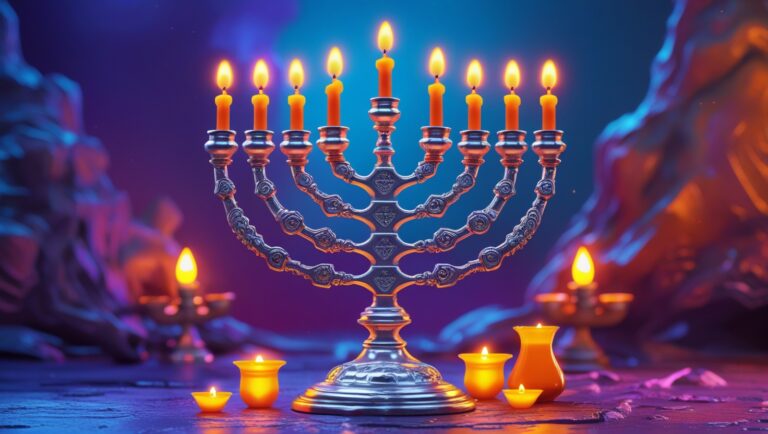The Talmud recounts a famous story involving Rabbi Yehuda Bar Ilai and two dead girls buried in a cemetery
Do the dead know what is happening? This question was posed in the Zohar and in the ancient texts of the Talmud, there is a fascinating discussion that sheds light on the mystical beliefs surrounding the deceased and their awareness of earthly matters.
Short answer, yes. Long answer, it’s more complicated.
The story is found in Tractate Berakhot, page 18b, and this passage explores the notion that those who have passed on may still possess knowledge of events in the world.
The narrative begins with the sons of Rabbi Chiyya, esteemed scholars, who ventured into a village and, in their preoccupation, forgot their teachings. Struggling to recall their learning, one of them wondered aloud, “Does our father (Rabbi Chiyya), who has passed away, know of our difficulty?”
His companion skeptically responded, citing the verse from Yiov 14:21 which states, “His sons receive honor and he does not know.” According to this viewpoint, the deceased are unaware of events transpiring among the living.
However, another son countered with a different verse from Yiov 14:22, asserting, “But his flesh grieves him and his soul mourns for him.” This verse implies a deeper connection, suggesting that the departed may indeed be aware of matters concerning them, namely in this case, when the soul mourns for the body’s decay.
This debate sets the stage for a deeper exploration into the mystical understanding of the afterlife.
Another tale about the dead
Let’s remind ourselves that the Tannaim were had unbelievable knowledge of Torah and Kabbalah. Nothing they did was simple and, while the Arizal gives many good reasons for their behavior, many times we are left in the dark as for the real reason behind their actions. This is not halacha for us in any way, shape or form.
Rabbi Yehuda Bar Ilai, one of the greatest Tannaim had serious conflicts with his wife, and to escape the arguments and get some rest, he would go to the cemetery to sleep. This is of course forbidden in our days, and even the Talmud cautions against doing that lest a spirit possesses a person. But he was one of the greatest sages of his time.
Rabbi Yehuda Bar Ilai was poor and during a time of famine, as he gave a coin to a pauper, he incurred the displeasure of his wife. Upset, he sought solace in the cemetery and overheard a conversation between two spirits. One spirit (a girl) expressed a desire to travel the world and eavesdrop on discussions about impending punishments from beyond the partition of the spiritual worlds. However, she explained that she was unable to do so because she was buried in a mat of reeds. Her companion agreed to go in her place and returned with news that anyone planting during the first rainfall would suffer crop damage from hail.
Rabbi Yehuda Bar Ilai could hear these two dead girls talking about the upcoming harvest. Thanks to this information, he knew exactly what to plant, whether it was corn, wheat, or potatoes, what to harvest, and where to work in the fields, all based on the conversations of these two dead girls. This shows that the dead have valuable information to offer us.
Taking heed of this information, he planted his crops during the second rainfall and thus avoided the devastation that befell others. The following year, a similar scenario unfolded, with the spirits warning about blight affecting crops planted during the second rainfall. Again, the pious man planted during the first rainfall and safeguarded his harvest.
When questioned by his wife about his exceptional fortune, he shared the tale of the spirits from the cemetery. Intrigued, his wife sought confirmation from the deceased girl’s mother, who verified the existence of her daughter’s burial place in a mat of reeds. Apparently, for some reason, this kept the girl from rising to the higher spiritual worlds.
Either way, this revelation affirmed the belief that the deceased, despite their physical state, do retain a degree of awareness and can influence events in the world. They are around the world.
The story concludes with a poignant moment when Rabbi Yehuda Bar Ilai returned to the cemetery and overheard the spirits discussing their ability to hear the words exchanged among the living. This final revelation solidifies the notion that the departed possess a form of knowledge that transcends physical boundaries.
The three main judgments
The Zohar teaches that there are three main forms of judgment that souls go through:
- The first one is called Khibut HaKever (tr.: beating of [in] the grave), and here the soul comes back to the body after being buried to be beaten up. While this sounds horrible (and is), this is meant to take out the Tumah from the vestment of the soul. The simplest way is to imagine you jump in a mud, and now need to clean your clothes. You don’t just drop them in the washing machine directly, rather, you beat it up forcefully to remove the big clumps of mud before.
- The second one is the Kaf HaKelah (tr.: pouch of the slingshot), and this is another painful form of cleansing in which the soul is bound in this world, usually running around with destroying angels to beat it up. Again, this is to take the smaller clumps of mud and here the soul can be contacted and even enter or possess a living person.
- The third one is Gehinom, which is usually translated as hell. Here is (generally) the final step, in which the soul has not much to do except endure the suffering. There’s respite on Shabbat, and while in the second step, one can screw up more, here there’s not much wiggle room: he will get cleansed. Again, this is only meant to purify the soul.
We should keep in mind that the foremost concern in Hashem’s mind is to clean the souls so they can rise and enter Gan Eden. This is reported from R’ Yehuda Fetaya’s book Minhat Yehuda chapter 88, in which he asks an angel whether it’s “wrong of him” that he rectifies souls through Yichudim (so they don’t need to go through all the suffering). The angel said he simply don’t care; their job is to cleanse the souls and whatever gets the job done is sufficient and good in Hashem’s eyes.
We have also other sources for that. Sefer Hasidim, written by Yehuda HaHasid about 800 years ago in Germany, clarifies in part 1029 that when the dead want to manifest, they can do so and appear as they did when they were alive. They can also take on the appearances of previous incarnations. This apparently happen even if they are already fully rectified and don’t require actual reincarnation. This concept is also supported by the writings of Rabbi Abraham Abulafia.
Either way, they don’t always have the same appearance in each incarnation. Sometimes they are taller or shorter, fatter or thinner, male or female, and our skin tones can also change. When we talk about how our deceased relatives manifest, these “malbushim” (i.e.: layers of spiritual clothing) with which they appear, are connected to this material, especially to the vestments of Shabbat.
The Arizal dressed in white on Shabbat, as clothing reflects the spiritual state. This is mentioned on page 72 of Sha’ar HaKabanot in relation to dressing in white. The whole idea of dressing in white on Shabbat is significant. Why dress in white on Shabbat? The answer is that colors matter deeply as they define the quality of the vestment of the souls, as everything else.
In summary, according to Kabbalah, the dead can reveal valuable information and manifest in different ways, providing us with a direct connection to the future.
The idea here is that on a deeper level, your Ruach (spirit) already know what is going to happen. The highest aspect of yourself, known as Ruach HaKodesh, inherently knows what decisions to make, and we can all learn how to contact it.
This knowledge comes from the most evolved version of yourself at any given moment. On Chaguim (festivals), we all have better access to the higher levels of Ruach and Neshamah (soul). In future posts, we will b’ezrat Hashem explore how to prepare yourself to receive this information and avoid the obstacles that can block your Ruach from communicating with you.
Remember, the goal is to gain knowledge through your Ruach and you don’t need to be like Yosef HaTzadik for this (though it helps).
While the Chaguim are more sparse, we have 53 opportunities a year, known as Shabbat, to make full use of our higher faculties through meditation. And the Arizal teaches that the Shabbat’s influence can extend into the week. This is why some kabbalists perform Havdalah (a ceremony that marks the end of Shabbat) as late as Tuesday night, indicating Shabbat’s extended influence.
May we merit to have the revelation of our Ruach.







